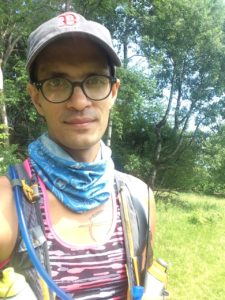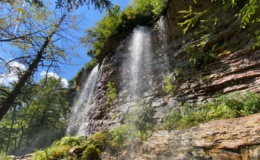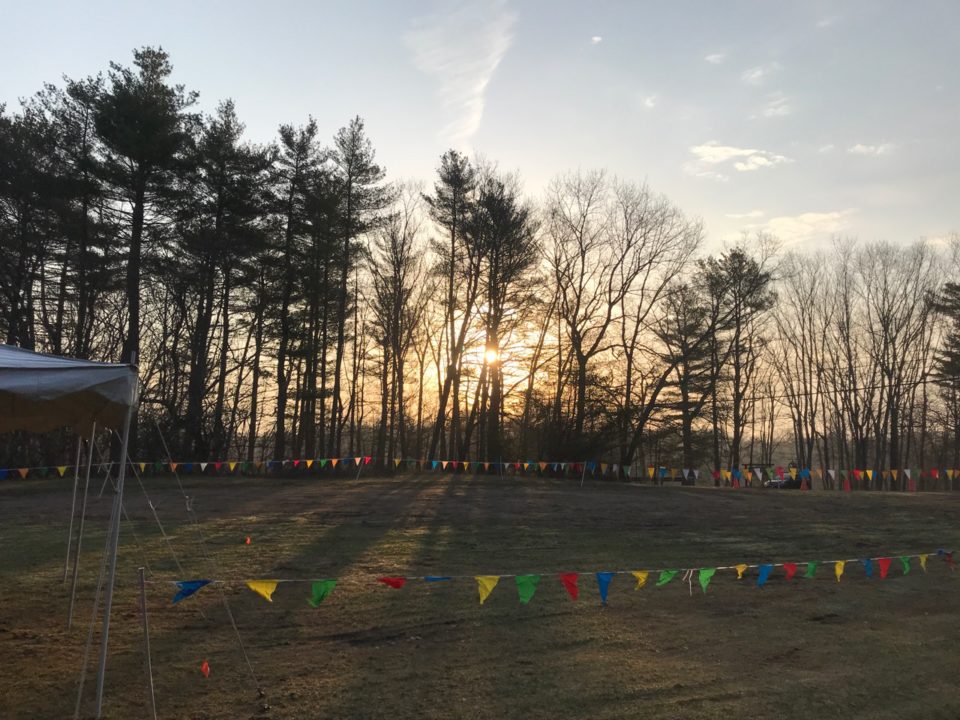Catamount 50k
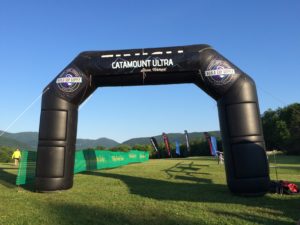
Having done this race last year I knew what I was getting myself into, this wasn’t my first ultra, and it wasn’t a particularly technical course–although I have heard differently from some people. Thus to make it a bit more challenging, I decided to try this race barefoot. I’m not a stranger to barefoot running, I enjoy it on trails. Feeling the softness of the earth, the mud, the scratchiness of pine needles, all of it–I love it! There are some trail systems that are more conducive than others, and I felt Catamount would be one of them.
In my mind the race was a series of conversations I had with others, and observations about the course–and that’s largely what this report will reflect. The catamount ultra is two loops of a 25k course, with one major hill in the first 5 miles of each loop.
Last year my time was 6h 42m, but I knew that being barefoot I would end up near the 8 hour mark.
The race started out at 7am next to the lovely Trapp Family Lodge, in Stowe, VT. There was a mere 120 of us, and after a quick pre-race meeting discussing some of the minor course changes, Will–the RD– had us line up. I took my position in the back. The race started with “Welcome to the Jungle,” being played over the speaker–not my type of music, but there are plenty of things in store that would not be to my liking. If I wanted things to be perfect, I would have spent the day on the beach.
In any ultra that I do, I need to know that there is some risk of failure—failure of my own goals. Without risk, there is no hope that I will be able to grow as a runner, or as a person. I seek to push myself in way that will benefit many parts of my life.
The course’s first minor incline is apparent as the music fades. Many runners walked here, knowing that there were more climbs ahead, and a hot day in store. Many times during the first two hills, I found myself managing the small pebbles really well, and passing loads of people. My pace uphill was a brisk one, power walking where I could. The morning was still relatively cool, and I found myself having energy.
The major hill on the course is Round Top, rising just under 700’ from the bottom of Chris’ Run. There were some sections of this course that were a real slog—parts at a 20% grade. But having made it to the top, we were awarded with an aid station.
A guy by the name of Brent asked, “No shoes?”
“Nope, don’t need them.” I responded.
After a quick bite of potatoes and salt, and an application of bug spray, I headed down the mountain. Down is a relative word, since there was another 100’ of uphills as well. But most of the next 4 miles was downhill. Brent and I got into talking a bit on the first section, we chatted about barefoot running, and ultras, and running while raising a family.
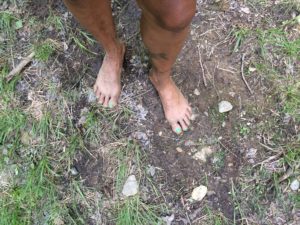
Between miles 22 and 24 is what I call “pebble road.” The first time through I managed to run along the edges of this fire road, which had small pebble or gravel sized rocks. On fresh feet I had no problem—but I had a feeling the second time through would be tough. There is a grassy section of this trail—the Chute Bypass—which shoots you out into a side trail for a bit, but then its back to the pebbles. Soon afterwards runners are awarded with a hard packed dirt road, and finally Aid #2.
By this point the sun was out, and blazing. These last 6 miles before the end of loop 1 was in and out of grassy fields and wooded trail.
Just before Trapp Hill Road I found two runners plugging away. As I approached one said to the other, “Oh, barefoot guy is behind us.”
The other, whom I believe was Canadian based on his accent asked, “The feet are feeling ok?”
“Yep, the feet are feeling fine,” I said happily as I passed them. “Have a good time!”
Over the next 3 miles a few of the leaders of the 25k passed me, but otherwise it was just me. Passing through one of the grassy fields I found my ankle starting to ache. It ached enough that I thought briefly about dropping at the start/finish, but decided that I wasn’t in enough pain to call it off.
Loop 2:
At the start/finish area, I turned around quickly, and headed back out—not even stopping for water. Had I stopped, I may have been there for good. The second running was definitely more difficult, and my ankle discomfort meant that I was stopping more often to massage it. Massaging meant a few more miles of worry free running. I also began calculating how much time I had left in the race, and what sort of minimum pace I needed to have to finish within the 9-hour cutoff.
Up and over Round Top was relatively easy—hot, but easy. As I approached “pebble road,” I slowed down quite a bit—more than I had hoped. Most of this time was spent walking—slower than a 25 pace. The Chute By-pass’ soft earth was a welcome site, and I ran all of that, but the sections before and after were the most difficult. I worried how much time I lost during this section, and if I would have enough time to finish.
Just after the hard-packed dirt road, I came upon a volunteer. She said, “With your bare feet, I didn’t even hear you coming.” I didn’t really say much as my attention was focused on pain management, but I smiled and gave her a thumbs up.
At Aid #2, the second time, I sat down and at a bunch of watermelon. Miss Vermont was hanging out at the aid station as well. One of the aid volunteers looked at my tattoo on my shoulder and asked, “Is that Paddington Bear?”
Miss Vermont looked confused, and quickly corrected him, “No, that’s Garfield.”
“Yep, and Odie on the other side.” I smiled.
The last 6.1 miles:
I had 2.5 hours left. Usually an easy proposition, but my ankle was really yelling at me. Miles 25-27 were the worst for me. I wasn’t sure that I could make the cutoff, I questioned why I decided to go bare foot, I thought my friends who were waiting at the end would be pissed that I was taking so long to finish. I thought my wife would be upset that I took on such a challenge, I felt that I wanted to cry. That’s when I knew my blood sugar was low and immediately drank a bunch of tailwind/water from my hydration pack—when the emotions came to the surface. That helped calm down my mind. But I still had the thought that maybe I should drop at the water station on Trapp Hill Road.
The dropping out conversation in my head boiled down to 3 scenarios:
- Drop at the water station, and get a DNF.
- Keep going, make it to the finish line, but not make the cutoff, and get a DNF.
- Keep going, and maybe push through the self-doubt, and finish.
All the options meant I would have done an ultra in bare feet, but option 1 would lead me to hang out with my friends and get something to eat/drink, and rest my ankle—and it still would have been an ultra distance. Options 2 and 3 were really the same—with the difference being how much I wanted to push through the ankle pain.
I kept going—Option 3 was the goal.
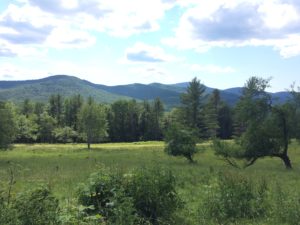
At mile 29.5, I started getting group text messages from my friends who had finished, and friends who were cheering us on from Massachusetts. Even though I was still plugging away in a bit of pain, hearing from my friends brought a smile to my face. With renewed energy, I pushed through the final uphill, and another hard packed road.
As I approached the finish, I heard a group of people off on one side say, “Oh there’s the guy who ran barefoot!”
And another respond, “Are you serious?!?”
And finally seeing my two friends cheer me on, as well as the race director—who informed me he thought this was the first time someone ran his course barefoot.
Post-race:
The big question on most people’s mind has been: “How are your feet?”
They are not cut up, no blisters. My ankle pain didn’t blow up into any inflamation—it has just been very tight. I can tell my opposite quad is also very tight—most likely from me compensating during the race.
